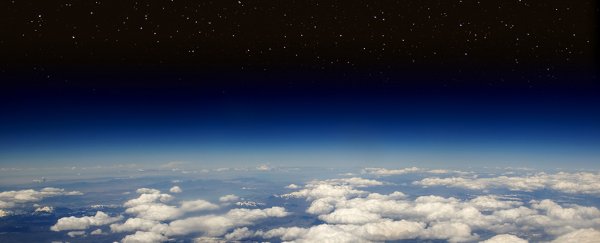Advances in technology have finally allowed researchers to measure the amount of a rare form of nitrogen molecule in our atmosphere, which it turns out isn't quite as rare as they expected.
The surprising result not only tells us something about the chemistry high up in our own atmosphere, it might provide us with a signature we could use to determine the potential for life on other planets.
While our atmosphere's oxygen often gets all the glory, it's actually boring old nitrogen that makes up almost 80 percent of every breath we suck down.
Most of the atoms in those molecules have an atomic mass of 14. But less than one percent of nitrogen atoms are actually packing a little extra, with an added neutron making them into an isotope called 15N.
Every now and then two of those isotopes will combine into a molecule of nitrogen gas, giving us 15N15N. That should make them pretty rare, but until recently nobody had confirmed just how uncommon the union is.
Sifting them out of the air using a mass spectrometer – a device that sorts molecules based on the ratio of their mass to their charge – is challenged by the fact a similar atmospheric chemical called nitric oxide (NO) also has an atomic mass of 30.
In fact, the difference between the two chemicals is a measly two one-thousandths the mass of a neutron.
Nitric oxide, a common pollutant as well as a product of many geochemical reactions, only makes up a tiny part of the atmosphere. But it's been enough to swamp any readings of 15N15N molecules.
But now, using a state-of-the-art instrument that managed to detect the difference, researchers from the University of California Los Angeles (UCLA) have discovered there's a little too much of this heavy form of nitrogen. A whole two percent extra, to be exact.
"Our one-of-a-kind Panorama mass spectrometer allows us to see this for the first time," says Edward Young, a geochemist and senior author of the study.
"We conducted experiments showing that the only way for this excess of 15N15N to occur is by rare reactions in the upper atmosphere. Two percent is a huge excess."
One possible source of these double nitrogen-15 molecules could be biological. Denitrifying bacteria commonly found in the soil can selectively take nitrates in the environment and expel nitrogen gas.
To see if they might be responsible, the researchers experimented with two species of denitrifying bacteria and one nitrogen-fixing species to see if they could account for any biases.
"There was a bit of enrichment in the biological experiments, but not nearly enough to account for what we'd found in the atmosphere," says earth scientist Laurence Yeung from Rice University in Houston.
One experiment that did indicate a significant source used high-voltage radio-frequency discharges, simulating nitrogen chemistry high above the planet's surface.
Samples of air taken from the stratosphere and dissolved in sea water helped to confirm the origins of this species of nitrogen gas.
"We think the 15N15N enrichment fundamentally comes from chemistry in the upper atmosphere, at altitudes close to the orbit of the International Space Station," says Yeung.
That doesn't mean life is insignificant, however.
"In fact, it meant that the process causing the atmospheric 15N15N enrichment has to fight against this biological signature," says Yeung. "They are locked in a tug-of-war."
It seems if anything the end figure of 15N15N is a compromise between species of microbes that fix and release nitrogen, and the chemistry in the atmosphere's upper reaches.
For geochemists, this discovery is a huge leap in understanding the dynamics of our atmosphere's chemical soup.
"But it also gives us a clue about what signatures of other planets might look like, especially if they are capable of supporting life as we know it," says Young.
Looking for similar characteristics in the make-up of other atmospheres would be a handy way to highlight planets that potentially have some sort of odd chemistry. Chemistry that may suggest our planet isn't all that unique after all.
This research was published in Science Advances.
